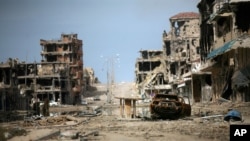Libya is suddenly on the lips of President Donald Trump and his hawkish national security adviser John Bolton ahead of the much-vaunted summit with North Korea leader Kim Jong Un, or more precisely, the "Libya model" is.
There seems to be a disconnect between the two on what that actually means — and it won't be assuaging anger in Pyongyang, already bubbling over this week with leverage-seeking threats to skip the summit in Singapore on June 12.
Bolton was referring to the nuclear deal in 2003, which saw the north African nation give up its weapons of mass destruction in exchange for sanctions relief, whereas Trump has focused on events eight years later which saw the mercurial Libyan leader Moammar Gadhafi toppled and killed in 2011.
Trying to address the North Korean concerns, Trump said if Kim were to agree to denuclearize, "he'll get protections that would be very strong." But Trump warned that failure to make a deal could have grave consequences for Kim. Mentioning what happened in Libya when it gave up its nuclear program, Trump said, "That model would take place if we don't make a deal."
"The Libyan model isn't the model we have at all. In Libya we decimated that country," Trump added. "There was no deal to keep Gadhafi."
Some analysts say bringing up Libya at all jeopardizes progress in negotiations with North Korea.
Keeping the West at bay with WMD deal
Gadhafi was the leader who ruled his oil-rich nation for decades, reviled by successive western governments, and blamed for orchestrating terror attacks in Europe and the Middle East, who came in from the cold in late 2003. South African leader Nelson Mandela had also publicly thanked Gadhafi for his support for the African National Congress throughout apartheid's darkest days.
In the post 9/11 and Iraq War era, he was obsessed with deposed Iraqi leader Saddam Hussein's fate.
With great fanfare President George W. Bush and British Prime Minister Tony Blair announced the deal. Gadhafi had agreed to dismantle all his weapons of mass destruction. And it kept him safe until the Arab Spring.
Death in the desert
The Libyan chapter of the Arab uprisings sweeping the region in 2011 was the first to take a violent turn, spiraling into civil war with atrocities committed both by Gadhafi's forces and popular opposition forces. Western forces intervened on the rebels' side, with punishing air strikes which proved a major catalyst to Gadhafi's fall.
In gruesome images many around the globe saw almost in real-time on October 11, 2011, with the age of social media in full flow, Gadhafi was captured in his native Sirte by rebels from Misrata, a region that had suffered greatly at his hands. They humiliated him in his death throes as he pleaded, "What did I do to you?" They then paraded his corpse for days so the nation would believe he was dead.
Kim took power weeks after Gadhafi's death. North Korea sees Gadhafi's death as a cautionary tale to, in part, justify its own nuclear development in the face of perceived U.S. threats.









